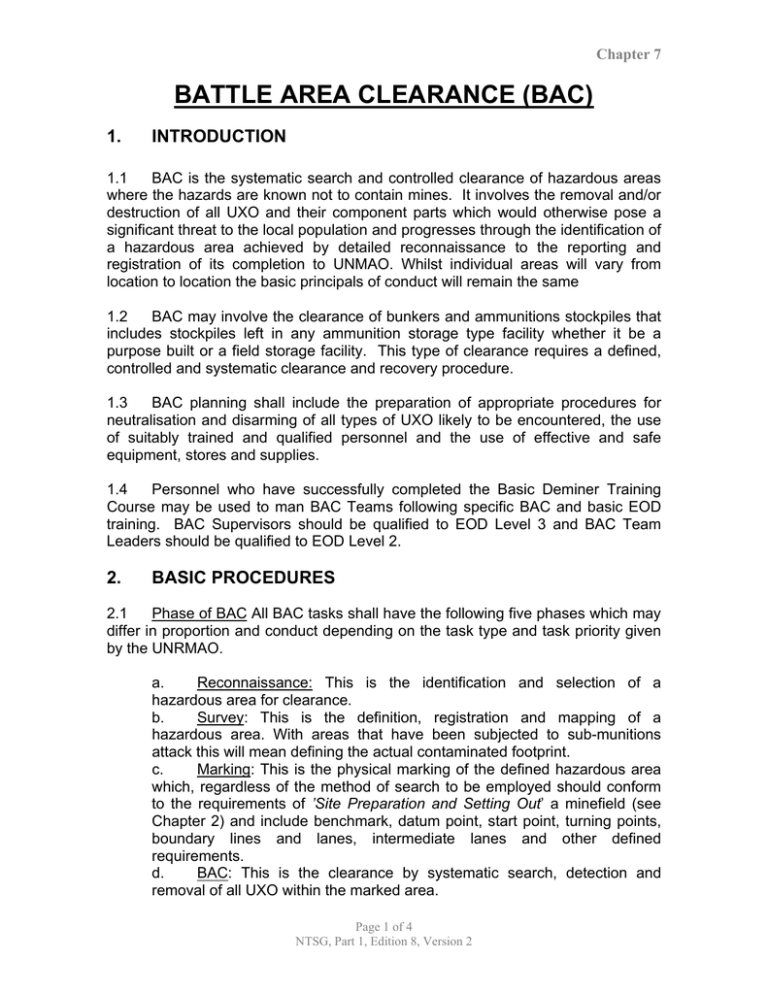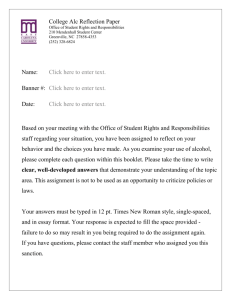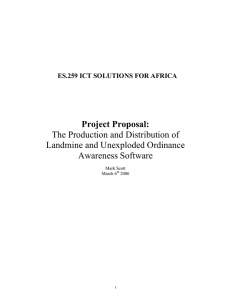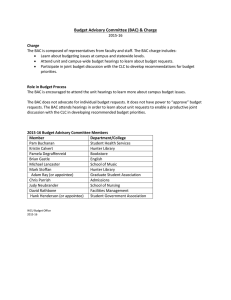Battle area clearance - International Mine Action Standards
advertisement

Chapter 7 BATTLE AREA CLEARANCE (BAC) 1. INTRODUCTION 1.1 BAC is the systematic search and controlled clearance of hazardous areas where the hazards are known not to contain mines. It involves the removal and/or destruction of all UXO and their component parts which would otherwise pose a significant threat to the local population and progresses through the identification of a hazardous area achieved by detailed reconnaissance to the reporting and registration of its completion to UNMAO. Whilst individual areas will vary from location to location the basic principals of conduct will remain the same 1.2 BAC may involve the clearance of bunkers and ammunitions stockpiles that includes stockpiles left in any ammunition storage type facility whether it be a purpose built or a field storage facility. This type of clearance requires a defined, controlled and systematic clearance and recovery procedure. 1.3 BAC planning shall include the preparation of appropriate procedures for neutralisation and disarming of all types of UXO likely to be encountered, the use of suitably trained and qualified personnel and the use of effective and safe equipment, stores and supplies. 1.4 Personnel who have successfully completed the Basic Deminer Training Course may be used to man BAC Teams following specific BAC and basic EOD training. BAC Supervisors should be qualified to EOD Level 3 and BAC Team Leaders should be qualified to EOD Level 2. 2. BASIC PROCEDURES Phase of BAC All BAC tasks shall have the following five phases which may 2.1 differ in proportion and conduct depending on the task type and task priority given by the UNRMAO. a. Reconnaissance: This is the identification and selection of a hazardous area for clearance. b. Survey: This is the definition, registration and mapping of a hazardous area. With areas that have been subjected to sub-munitions attack this will mean defining the actual contaminated footprint. c. Marking: This is the physical marking of the defined hazardous area which, regardless of the method of search to be employed should conform to the requirements of ’Site Preparation and Setting Out’ a minefield (see Chapter 2) and include benchmark, datum point, start point, turning points, boundary lines and lanes, intermediate lanes and other defined requirements. d. BAC: This is the clearance by systematic search, detection and removal of all UXO within the marked area. Page 1 of 4 NTSG, Part 1, Edition 8, Version 2 Chapter 7 e. Reporting: This is the accurate, punctual recovery and dissemination of cleared area information in the form of a suspension or completion report. 3. METHODS OF SEARCH & MINIMUM GUIDELINES 3.1 Selection of which method to use is dependent upon clearance instructions, terrain, vegetation etc. A combination of different search methods will normally be employed in order to achieve the desired result. Regardless of the method employed all personnel entering within 100m of the hazardous area will wear appropriate PPE. 3.2 Methods that may be used include: a. Visual Search - is the most effective method of removing the immediate threat from a hazardous area. It must be strictly controlled to ensure that the complete area is systematically searched. The following applies: (1) The vegetation, terrain and environment will dictate the number of deminers making up a BAC team and the spacing between these individuals. (2) The TL must be able to see and hear all deminers at all times. (3) Each deminer must be able to visually search the area he/she is responsible for at all times and must be able to hear the TL at all times. (4) BAC teams shall not search continuously for more than 60 minutes without at least a 10-minute break. (5) A team will be allocated a ‘box’ to search and this will be further segmented into ‘lanes’ of a width determined by the restrictions detailed in paragraphs (1), (2) and (3) above. (6) A minimum safety distance of 50 metres is maintained between each BAC team but it may be necessary to increase this depending on the fragmentation threat. (7) Each lane will be searched until the whole box has been covered. Once a box has been searched and all UXO found is marked, the team can then move onto the next box. (8) Searching shall always be carried out in complete silence, except for instructions given by the TL and on the identification of a UXO by a deminer. (9) Any deminer who identifies an item of UXO is to immediately alert the remainder of the team and the TL. Under no circumstances shall the UXO be moved or disturbed at this stage. (10) After an evaluation by the TL the UXO is to be appropriately marked. (11) In those areas where sub-munition clearance is being conducted, the location of cluster bomb strike marks should be recorded to assist in the identification and future evaluation of the strike area footprint and boundary. Page 2 of 4 NTSG, Part 1, Edition 8, Version 2 Chapter 7 (12) All items of UXO that have been identified are to be rendered safe either by disposal by detonation/burning or if safe to do so, recovered to a central storage area for demolition at a later date. All sub-munitions are to be destroyed in situ. b. Instrument Aided Visual Search – used to assist visual search procedures when the density, covering and/or spread of vegetation hinders progress, effectiveness, efficiency and safety. Numbers of deminers, allocation of tasks, adequate supervision and overall conduct of this method of search must take into consideration the use of detectors whilst applying the details of paragraph 3.1a (1) to (12) as closely as possible. c. Sub-surface Search – may be employed initially or following a visual search of the contaminated area. Dependant upon methodology and equipment used deminers may work singularly, in pairs and even in threes1 but this should be the maximum. Regardless of this the following applies: (1) The weather, terrain, environment, instruments and equipments being used and fragmentation threat shall dictate the composition of deminers and the spacing between each. (2) The TL shall allocate each deminer a box. He must be able to see and hear all deminers at all times. (3) Each deminer must be able to visually and instrumentally search the area they are responsible for at all times and must be able to hear the TL at all times. (4) A deminer shall not search continuously for more than 60 minutes without at least a 10-minute break. (5) A deminer will be allocated a ‘box’ to search and this will be further segmented into ‘lanes’ of no more than 2m width taking into account the restrictions detailed in paragraphs (1), (2) and (3) above. (6) A minimum safety distance of 25 metres is to be maintained between each deminer but it may be necessary to increase this depending on the fragmentation threat. (7) Each lane will be searched until the whole box has been covered. Once a box has been searched and all UXO found is marked, the deminer can be moved to the next box. (8) Searching shall always be carried out in complete silence, except for instructions given by the TL and on the identification of a UXO by a deminer. (9) Levels of clearance will be identified during the tasking and will be dependant on the overall requirement, future use of the land and perceived threat. At all times any signal from the instrument that may reasonably be expected to be an item of UXO is to be investigated. (10) On location of a sub-surface signal, normal demining probe and excavation drills should be employed. Every effort must be made not to jolt, vibrate, strike or otherwise disturb the item giving the signal. The extent of excavations should be such that it allows the item to be positively identified. 1 Whichever entity is used reference to a single entity in this chapter is made by the term ‘deminer’ Page 3 of 4 NTSG, Part 1, Edition 8, Version 2 Chapter 7 (11) Any deminer who excavates and identifies an item suspected of being UXO is to immediately alert the TL. (12) After an evaluation by the TL any item of UXO is to be appropriately marked. (13) In all cases UXO and sub-munitions to a minimum depth of 20cm are to be located and removed/disposed of. (14) In those areas where sub-munition are expected the location of cluster bomb strike marks should be recorded to assist in the identification and future evaluation of the strike area footprint and boundary (see Annex B). (15) All items of UXO that have been identified are to be rendered safe either by disposal by detonation/burning or if safe to do so, recovered to a central storage area for demolition at a later date. All sub-munitions are to be destroyed in situ. 4. DISPOSAL OF UXO 4.1 All items of metallic scrap that have been certified as Free From Explosive (FFE) are to be stockpiled on site and arrangements made for its removal to a final place of disposal. 4.2 Any UXO should be disposed of by detonation/burning either in situ (if unsafe to move) or at a CDS (if safe to move) as soon as possible. In circumstances, where disposal cannot take place that day, the item is to be effectively marked, protected and the local inhabitants informed. 4.3 Items of UXO that are considered safe to move may be transported to a predesignated storage area for future bulk disposal. Excessively large quantities must not be allowed to accumulate. 5. REPORTING 5.1 Upon completion of a BAC task a Completion Report is to be completed and submitted to the UNRMAO. This should include the details of all demolitions conducted, explosive and accessories usage. These details shall also be detailed on the Weekly Summary Report submitted to UNRMAO. Page 4 of 4 NTSG, Part 1, Edition 8, Version 2


